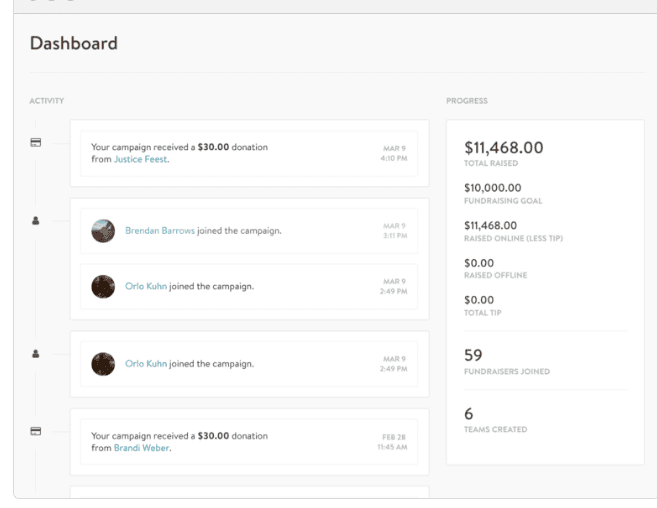If you get a bunch of fundraising professionals in a room, it won’t take long before some (good-natured) commiseration begins on one topic: Boards.
“… does your board fundraise? Mine, neither.”
Some nonprofit boards are great about fundraising. They consistently without complaint are inspiring others to support your organization. However, many struggle to get anything out of their board outside of complaints and far-fetched ideas.
The difference will be determined by how you communicate with, educate, and support your board.

- These 10 board members raised more than $18,000 with their peer-to-peer campaign.
Related post: 11 Essential Nonprofit Interview Questions for Hiring a Great Leader
What Is A Board Supposed To Do?
Some boards are very hands-on, and others are fairly removed from day-to-day operations, but all boards have some responsibilities in common. A board of directors oversees a nonprofit, making decisions to promote and sustain its mission. They set the compensation for the organization’s CEO or Executive Director, and are ultimately responsible for an organization’s finances and activities. The three major “duties” of a board are:
- Duty Of Care–The board makes sure that all of the organization’s resources are used responsibly. This is why boards approve budgets–they have the final responsibility to ensure the organization is using money appropriately. By agreeing to serve on a board, the board member has a duty to pay attention to the organization’s activities and finances and participate in decision-making.
- Duty of Loyalty– The board makes sure the organization’s activities advance its mission, not any one individual or for-profit entity. This is why boards are so interested in conflicts of interest–their duty of loyalty could be compromised if they stand to benefit personally from a nonprofit’s activities.
- Duty of Obedience–The board makes sure the nonprofit follows all laws and its own bylaws. This means that board members are required to understand applicable laws and the organization’s bylaws, and recognize what a violation could look like.
Fundraising is another commitment boards make. Whether your nonprofit has an explicit “Give/Get” requirement, or just strongly encourages fundraising, boards have a role to play in raising money for your organization
It’s fairly rare to hear about problems with serious governance issues, probably because there are actual, legal ramifications for boards that spend all an organization’s money, or use a nonprofit for their own gain. The problem that comes up, again and again, is simple, and not illegal: “My board won’t fundraise.”
Sound familiar? You’re not alone. BoardSource finds that many boards have trouble with their “external responsibilities,” especially fundraising. Fundraising is outside of many board members’ comfort zones. It requires a specific skill set, which they might not have. Yet.
Transforming Your Board Into A Fundraising Force
A board is more than the sum of its members. Each board member brings their connection to a broader network, and with it, the potential to expand your organization’s reach. When board members understand expectations, are engaged with your mission, and know what to do, they can take your organization places you’d never go without them. A board can be indispensable.
In order to become a fearsome fundraising force, your board will need some things from you: clear expectations, ongoing education, and helpful support.

- They know a lot of people. A lot.
Clear Expectations
A big part of building a culture of fundraising is making expectations clear. Do your current board members understand their roles and responsibilities? Are financial commitments understood? Do they know you expect them to fundraise?
It may seem obvious, but it’s very possible to join a board without realizing fundraising is part of the deal. That’s why fundraising should be part of your recruitment conversations. Not only does talking about fundraising save you from bad surprises later, it can seriously impact your board’s engagement with future fundraising.
BoardSource found in their 2017 survey of nonprofit board practices, Leading with Intent, that when fundraising expectations are clearly articulated during recruitment, 52% of executives report active engagement in fundraising, versus only 12% when fundraising expectations are not part of recruitment.
Add fundraising questions to your interview and onboarding processes, like:
- Have you ever raised money for charity? How did it go?
- What kind of fundraising activities are you most comfortable with? Least comfortable?
- What do you think you’d need (information, assistance, mentoring, etc.) to feel confident raising money?

- “I understand that fundraising is part of board service, and I’m ready to join your board.” “Excellent! I’m so glad we had this clear and necessary conversation!”
As you continue to work with the board, keep on spelling out expectations. If you expect board members to bring people to events, buy tickets to fundraisers, or supply in-kind donations for a raffle, say so. If you want them to introduce you to potential funders, ask their friends to contribute, or host a fundraising party, you need to tell them.
Education
Many board members get it. They know they’re supposed to help raise money for their organizations. They just don’t know how. Once they get some knowledge, they’re excited to begin.
As a fundraising professional, you have access to a lot of good information and training. Do you read blogs, receive newsletters, or get invited to classes? Share the wealth! Consider:
- Forwarding good blog posts and articles to board members
- Find articles that are short, relevant, and actionable
- Be careful of overwhelming them–an article about once a month is good for most people.
- Summarize whatever you send a link to, and explain why you think it’s useful
- Inviting your board president or other members to attend a seminar or class with you
- Have coffee afterward to discuss how you could apply what you’ve learned to your organization
- Ask them to report on the seminar to the other board members
- Spending a short period of time during each board meeting to talk about a different aspect of fundraising
- The more board members understand your fundraising strategy, the more they’re able to help
- Explain your terms. You know what an annual fund and a year-end appeal are, and what they involve, but your board members might not.
- Explain your techniques. It’s not overkill to say, “We’re sending a letter to 1,000 people, and expect a 2% return rate. We’ll send three follow-up emails, and post seven times on our social media before January.”
- Explain what they need to do. “Please share our social media posts with your own networks.”
- Spending more time on a specific fundraising topic during a board retreat
- Ask your board what they’d like to learn more about
- If they don’t have ideas, suggest topics you’d like them to focus on
- A board retreat is a good opportunity to work with a guest speaker or consultant
- Holding a fundraising workshop
- In a low-stress environment, encourage board members to talk frankly about their feelings about fundraising
- Working in small groups or pairs, let board members practice advocating for your organization and develop their own “elevator speech” about your cause and mission
- Encourage board members to identify their own reasons for supporting you, and practice sharing those reasons with each other.
- Role-play making asks
- Breaking down your fundraising reports further
- Include year-over-year comparisons, to give board members perspective on totals
- Include a short description of fundraising activities, as well as their results
- Include visual organizers like charts and graphs
Side Bar/Box/Etc: Reports That Educate
At CauseVox, we think reporting should be simple. That’s why our fundraising platform has intuitive back-office features, making it very simple to export data. Data is, of course, the heart of reporting.

- Look at all that data, nice and neat in one place!
Raw data is not enough for all boards, however. Once you’ve got your data, it’s worth taking a minute or two to break it into smaller pieces that are easy to understand. Toss in a graph or a chart for the visual learners. Summarize the report for the skimmers. Help your board understand what all those numbers actually mean.
Comparing totals year-over-year gives board members a better perspective on what success is. Tracking how many donors make more than one gift demonstrates the importance of donor retention. Including a short narrative description of your fundraising activities gives board members a clearer picture of what exactly it is you’re doing all day.
The time you spend making your data accessible to your board is well spent. A board that is educated about fundraising activities and results is more equipped to make good decisions about an organization’s finances and able to see how their help impacts fundraising.
Support
As a fundraising professional, you have a lot of skills and you know a lot of things. This can make it hard to determine when you’re asking a lot of people. Things seem simple when you know how to do them.
Let’s imagine that instead of a fundraising campaign, we’re trying to build a bookshelf. You, as a fundraising professional, are a master carpenter. If someone said, “Hey, build a bookshelf, would you?” to you, it would probably make sense, and you could do it without much bother. Voila, a bookshelf.

- Show off.
If someone asked a non-carpenter to build a bookshelf, it would not be so breezy. They would need to learn what tools and materials they needed, where to find them, how to use those tools, what the necessary components of a bookshelf were, and how to apply the tools to the materials to get the desired results. It would probably not be super fun, and their first bookshelf might not be very sturdy.

- You don’t need that many saws, for example.
If the most important thing is to have a bookshelf, why would we make a non-carpenter build one from scratch? Why don’t we send them to Ikea?
You know what’s great about putting together a piece of furniture from Ikea? It has everything you need. You don’t have to find a wrench, you don’t need to go buy screws, you don’t even need to read anything. They make it as simple as possible.

- Success!
You need to be the Ikea of fundraising for your board members.
Don’t make them go hunting for a Phillips-head screwdriver. Give them everything they need to succeed, including:
- A toolkit. A fundraising toolkit can contain:
- Templates for letters, emails, and social media posts
- Graphics and logos
- A calendar for the campaign
- Tips and strategy
- Background like your mission statement, history, and facts about your cause
- Regular check-ins
- Give them a call or send an email to see how it’s going
- Invite them to ask questions
- Encouragement and Feedback
- Thank them for sharing social media posts
- Call them if you get a check from someone they talked to
- Congratulate them when you see they’ve reached a fundraising goal or milestone
- Report on how the campaign is going, and suggest next steps to keep things rolling
Peer-to-Peer Fundraising
A peer-to-peer fundraising campaign is a great project for a board that’s getting started with (or recommitting to) fundraising, because:
- It’s hands-on. Peer-to-peer fundraising gives board members a short-term, structured way to practice their fundraising skills. They can set a goal, tell your story, and ask their family and friends for money. Asking is asking, and the only way to become comfortable is to practice.
- It’s easy to manage. Online fundraising simplifies the details of fundraising, getting you one step closer to being fundraising Ikea. When you use an online fundraising platform, board members don’t have to handle money or take pledges, and you can easily monitor the campaign’s progress.
- It empowers connections. Peer-to-peer fundraising also shows board members how powerful their connections are. It’s easy for board members to look around for millionaires and conclude that they don’t know anyone who could help your organization. A peer-to-peer campaign will show them that their networks are full of potential supporters.
- It builds confidence. Reaching a goal demonstrates that your board can, in fact, fundraise. It shows them that fundraising is worth the effort.

- A peer-to-peer campaign helps you reach your board’s broad network.
It’s All Good
Are you feeling a little overwhelmed? Remember, you don’t have to do everything tomorrow. Cultivating a fundraising board is an ongoing process. You won’t see change overnight, but you will see change over time.
The great thing is, whatever you do, even something small, will help your board fundraise more confidently than they did before. Whether your next step is to clarify your fundraising expectations, send a blog post to your board, or embark on a peer-to-peer campaign, your board will be more likely to be successful fundraisers when you give them the tools they need, and then give them a chance to shine.
And who knows? Maybe next time you get together with a bunch of fundraising professionals, you’ll get to be the enviable person who says, “My board? Yeah, they’re pretty great about fundraising.”

Types of Nonprofit Board Member Personas
Board Member: Shy Sheila
Sheila joined the board of XYZ nonprofit because she believes in its mission. She makes an annual contribution and attends all of the organization’s events. She’s introverted and shy, and the thought of directly asking for money makes her feel vaguely sick. She may directly tell you she’s uncomfortable fundraising, or she may simply not do it.
Tips For Shy Sheila:
- Don’t pressure her to make asks
- Invite her to participate by thanking donors who make gifts
- Ask her to introduce you to people who may be interested in your organization
Board Member: Rich Randall
Rich Randall has a good deal of personal wealth. (That’s not the problem.)When asked to fundraise, he’d rather just write you a check. This is very generous, but it also limits your organization’s reach, creating a less sustainable donor base.
Tips For Rich Randall:
- Acknowledge his generosity
- Encourage him to share connections as well as cash
- Invite him to offer a match for a fundraising campaign, rather than simply giving the money
Board Member: Enthusiastic Ed
Enthusiastic Ed is ready to help! He’s so excited, he’s sending you fundraising articles. He wants the organization to partner with his neighborhood association, hold a food drive, and run a peer-to-peer campaign, all at the same time. His enthusiasm is terrific, but he may have more ideas than you can use, or get a little off-mission in his excitement.
Tips For Enthusiastic Ed:
- Truly consider his ideas, don’t brush them off.
- Give him opportunities to share his enthusiasm for your organization. He’s the guy to put at your information booth at street fairs or send to the Chamber of Commerce meeting on your behalf.
- Clearly explain your fundraising priorities and strategy, so he can be most helpful.
- Enthusiastic Ed is often a great partner for Hesitant Harriet
Board Member: Hesitant Harriet
Hesitant Harriet would fundraise if she only knew how. She’s careful about diving into things and wants to do a good job. She might think fundraising is very complicated, or that she’s going to mess something up.
Tips For Hesitant Harriet:
- Education is really important for Hesitant Harriet. If she doesn’t feel confident that she’s doing it right, she won’t move forward
- Encourage her efforts and reassure her that she’s doing a good job
- Peer-to-peer online campaigns are a great jumping off point for Hesitant Harriet, because they’re structured.
Board Member: Hostile Helen
Hostile Helen is rare, but if she’s on your board, you’ll know it. She does not want to fundraise, and gets defensive if you ask her about it. She may call fundraising “begging for money,” and look down on the whole thing. She’s not shy, she’s not hesitant, and she’s not mildly opposed–she’s intense about it. You probably can’t change her mind, so the biggest concern is not letting her hostility slow down or distract the rest of the board.
Tips For Hostile Helen
- Don’t ask her to fundraise. She’s not going to do it, and asking will just reactivate her negativity.
- Avoid giving her a platform to talk about how much she hates the idea of fundraising–don’t ask her directly to weigh in on fundraising topics. If she jumps in, redirect her to consider the problem of needing money and how to solve that, rather than her personal feelings about fundraising. (Hint: She’s probably going to tell you to write more grants, or stop using color paper in the printer. Take a deep breath.)
- Redirect her to the things she does want to do for your organization
- If she happens to decide to leave the board, don’t try to dissuade her. This may be harder to do if you’re in a situation where Hostile Helen and Rich Randall are the same person, but take another deep breath and remember: A board member who’d rather not be there is a lose-lose proposition. It’s better to gently let people go on the best possible terms.











